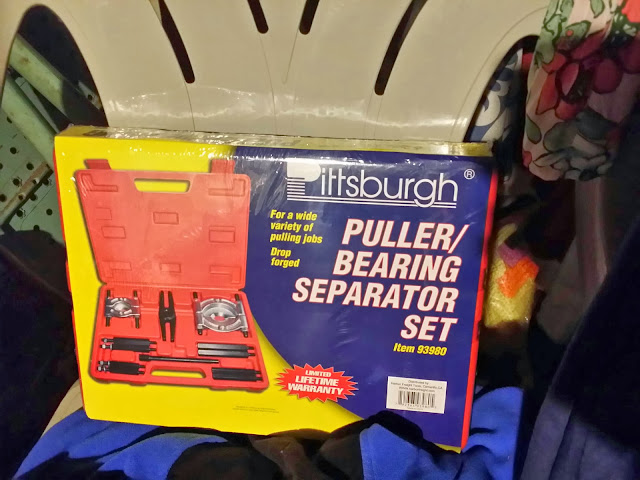So I left off having done the hard part yesterday, taking off the hubs. Today started off with a bang. Literally. Smacking the rest of the bearing out with a hammer:
For the record, I hate pine needles and working around, or specifically under, pine trees. Geez.
Don't forget to pop the dust shield off the back of the knuckle when removing the lower ball joint (again using a hammer since I was there and it was easy):
I managed to strip a few of the screws that hold the dust shield in place:
They will get drilled out and replaced. I want to pull EVERYTHING apart and clean it all off so I can paint the whole knuckle. I want to do this once and do it right.
Speaking of cleaning, I busted out the WD40 and a green Scotchbrite pad and went to town on the bearing race of the knuckle:
This is what the other one looked like before I started:
The second one after the treatment:
It makes a good bit of difference! But, notice all the exterior gook that is going to have to come off. Not too tasty. Someone had lost an axle boot sometime previously.
I also cleaned up the bearing retaining rings:
So, I have two brand new bearing:
What's a guy to do? Take them apart! Wait . . . what? WHY? Because racecar. I had found a very interesting post on a forum detailing how to repack bearings with superior grease. I did some research on this and talked to a few people who race Honders and found that the smaller civic bearing hubs have issues when racing (with big, sticky tires, bigger brakes, blah blah blah) unless the grease is replaced with something designed to handle the higher heat input to the bearings. I was convinced enough to go through the trouble and the risk of breaking something I've never tried before. On with the pics!
The Timken bearing is actually a reboxed Nachi. I thought this was a good thing since Nachi seems to be a good name in bearings and it is made in Japan.
I decided to take apart the Koyo bearing first, so these next few pics of of the Koyo. I popped the inner races out:
Pried out the balls and kept them together in the Nachi/Timken bearing for safe keeping:
Then my fingers got really greasy so I didn't take a lot of pics, but I cleaned out the original grease as much as possible and got ready to repack the bearing with this:
Looking at the test reports for this grease, it is very evident that it is REALLY good without being ridiculously expensive or hard to come by. It was recommended highly by many several racers and I think it will serve me well. It has a very interesting texture. It isn't as waxy as the original grease and when you pull a glob out of the container, it leaves very, very long stringers almost like taffy, but much thinner.
I don't have ay pictures of the bearing after it was repacked, but, basically the grease is red instead of white. I didn't have any issues with it at all! Yay!
I was feeling pretty good and moved on to the Nachi:
Woah! I know it might not be easy to tell, but this bearing had VERY LITTLE GREASE IN IT compared to the Koyo. So little I was kind of concerned. I didn't really need to wait very long to have my concerns made moot by the fact that the first ball I popped loose also took part of the plastic cage with it:
Cue trombone: Wah wah waaaaaaah!
So, I won't be using THAT bearing. I've already ordered another Koyo. Live and learn. But, based on this, I will NOT be recommending Nachi bearings. The low amount of grease in the bearing from the factory is a huge concern to me, anyway.
Another view of the broken cage and also showing how little grease is packed in with the balls:
Since I didn't have any more bearings to bother with packing, I busted out the cheap wire brushes and set about cleaning up the hubs. Autozone wire brushes:
Clean and shiny hub, and also showing a bit too much aggression with the bearing seperator:
It's mostly just a surface blemish, it isn't a deep scratch. I'm not really worried about it at all.
I am going to take a powered wire brush to the hubs to really get all the rusty crud off before painting. Since I have to wait for the new bearing, I might as well clean and paint everything as best I can.
That leads to the next question: are these upper control arms for a CRX? I am terrible at playing this game. I can't easily compare them to the ones on my car, and they might just be from an Accord. Does anyone happen to know?
The last thing I did before I called it a night was to test fit my lug nuts on the new wheel studs. I figured it would be better to check BEFORE they get pressed in. Sure enough, one of the studs has an odd spot on it that really binds the lug nuts. I don't know if you can really see it in the next two pics, but it is a very slightly darker colored spot:
These don't break the bank. I will buy another one soon. I don't need it until I do the rears, which is likely a few months away yet.
That's about it for now!




















































